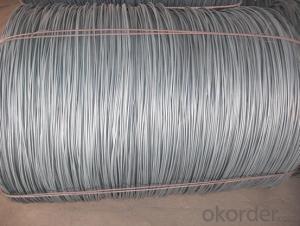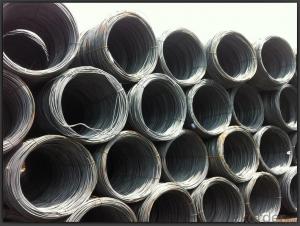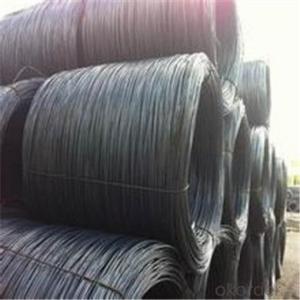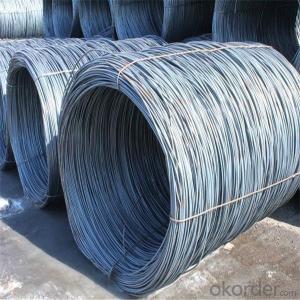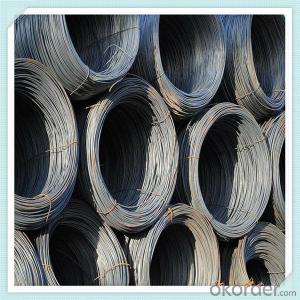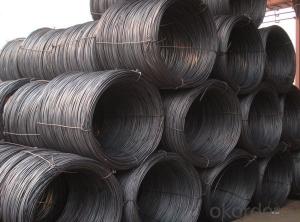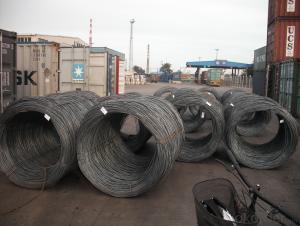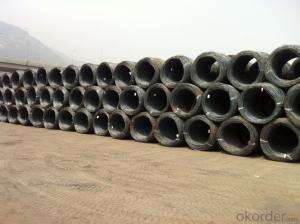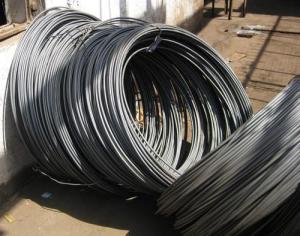Wire Rod Hot Rolled High Quality 5.5MM-14MM
- Loading Port:
- Tianjin
- Payment Terms:
- TT OR LC
- Min Order Qty:
- 25 m.t.
- Supply Capability:
- 2000000 m.t./month
OKorder Service Pledge
OKorder Financial Service
You Might Also Like
Specification
Product Description:
OKorder is offering high quality Hot Rolled Steel I-Beams at great prices with worldwide shipping. Our supplier is a world-class manufacturer of steel, with our products utilized the world over. OKorder annually supplies products to European, North American and Asian markets. We provide quotations within 24 hours of receiving an inquiry and guarantee competitive prices.
Product Applications:
After hot-rolled the products shaped into coil and delivery as finished product, including round, square, rectangular, hexagonal and so on. Since most of the products are round, it is generally called wire rod. Carbon steel wire rod is widely used in construction and manufacturing. Carbon steel wire rod is mainly used for reinforcement of reinforced concrete and welded structure or reprocessed (roberts , nail, etc.) materials, especially used to produce wire drawing, welding electrode, nails, spring, electronic, precise machinery parts and so on.
Product Advantages:
OKorder's Steel I-Beams are durable, strong, and resist corrosion.
Main Product Features:
· Premium quality
· Prompt delivery & seaworthy packing (30 days after receiving deposit)
· Corrosion resistance
· Can be recycled and reused
· Mill test certification
· Professional Service
· Competitive pricing
Product Specifications:
Manufacture: Hot rolled
Grade: SAE1008 SAE 1006
Certificates: ISO, SGS, BV, CIQ
Diameter: 5.5mm, 6.5mm, 7mm,8mm,9mm,10mm,12mm,14mm, as per customer request
Packaging: Export packing, nude packing, bundled
Grade | Chemical Composition (%) | |||||
C | Mn | S | P | Si | B | |
SAE1008B | 0.10max | 0.32max | 0.045max | 0.040max | 0.30max | 0.0008min |
Mechanical properties | ||||||
Yield strength(N/mm2) | Tensile strength(N/mm2) | Elongation (%) | ||||
≥195 | 350-380 | ≥32 | ||||
FAQ:
Q1: How soon can we receive the product after purchase?
A1: Within three days of placing an order, we will begin production. The specific shipping date is dependent upon international and government factors, but is typically 7 to 10 workdays.
Q2: What makes stainless steel stainless?
A2: Stainless steel must contain at least 10.5 % chromium. It is this element that reacts with the oxygen in the air to form a complex chrome-oxide surface layer that is invisible but strong enough to prevent further oxygen from "staining" (rusting) the surface. Higher levels of chromium and the addition of other alloying elements such as nickel and molybdenum enhance this surface layer and improve the corrosion resistance of the stainless material.
Q3: Can stainless steel rust?
A3: Stainless does not "rust" as you think of regular steel rusting with a red oxide on the surface that flakes off. If you see red rust it is probably due to some iron particles that have contaminated the surface of the stainless steel and it is these iron particles that are rusting. Look at the source of the rusting and see if you can remove it from the surface.
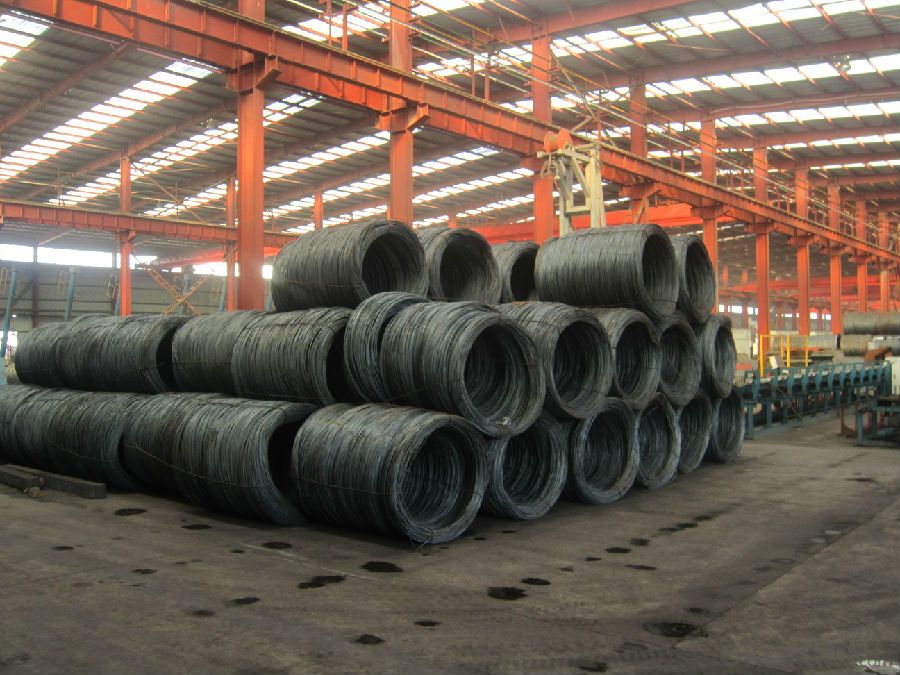
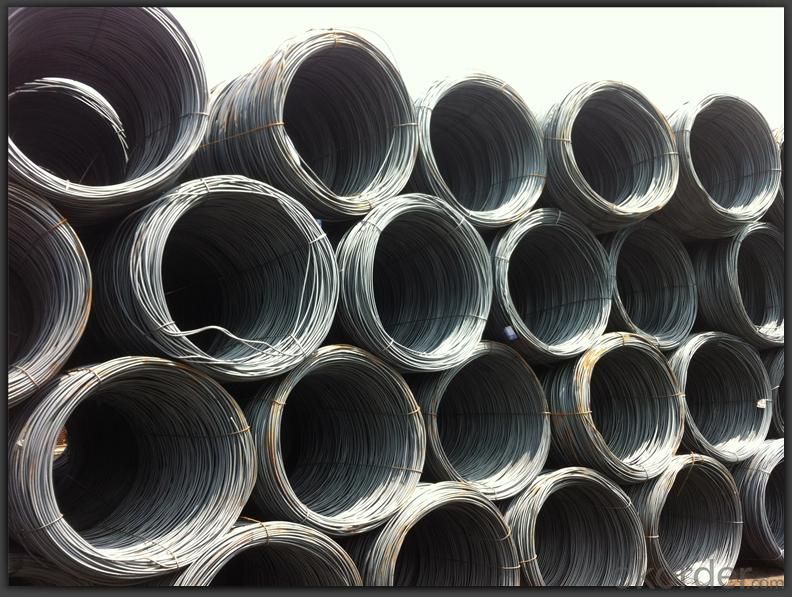
- Q: What are the advantages of using steel wire rod in mining applications?
- There are several advantages of using steel wire rod in mining applications. Firstly, steel wire rod offers high strength and durability, making it suitable for withstanding the harsh conditions and heavy loads in mining operations. Additionally, steel wire rod has excellent resistance to corrosion, which is crucial in underground mining environments where moisture and chemicals are present. Moreover, steel wire rod is highly flexible and can be easily bent or shaped to meet specific mining requirements, offering versatility in various applications. Lastly, steel wire rod is readily available and cost-effective, making it a cost-efficient choice for mining companies.
- Q: What are the main factors influencing the choice of steel wire rod packaging?
- The main factors influencing the choice of steel wire rod packaging include the weight and size of the wire rod, the required protection and safety during transportation, the storage conditions, the specific industry requirements, and the cost-effectiveness of the packaging solution.
- Q: What are the common sizes of steel wire rods?
- The common sizes of steel wire rods vary depending on their intended use, but some common sizes include 5.5mm, 6.5mm, 8mm, and 10mm.
- Q: What are the safety precautions when handling steel wire rod?
- Some safety precautions when handling steel wire rod include wearing appropriate personal protective equipment such as gloves, safety glasses, and steel-toed shoes to protect against cuts, burns, and eye injuries. It is important to handle the wire rod with caution, avoiding sharp edges and ensuring proper lifting techniques to prevent strain or injury. Additionally, proper storage and handling procedures should be followed to avoid tripping hazards and to prevent the wire rod from falling or rolling. Regular inspections of the wire rod and equipment should be conducted to identify any defects or potential hazards.
- Q: How is steel wire rod used in the manufacturing of wire decking?
- Steel wire rod is used in the manufacturing of wire decking as it serves as the primary raw material for creating the wire mesh panels that make up the decking. The steel wire rod is first drawn down to the desired diameter, then welded or interlocked to form a sturdy mesh pattern. This mesh is then attached to the supporting framework to create wire decking, which is widely used in storage systems to provide strength, stability, and airflow for storing items.
- Q: What are the different tensile strengths available for steel wire rod?
- The tensile strengths available for steel wire rod can vary depending on the specific steel grade and manufacturing process. However, common tensile strengths for steel wire rod range from around 500 MPa (megapascals) to 2000 MPa.
- Q: What are the different types of steel wire rod finishes for improved corrosion resistance?
- There are several types of steel wire rod finishes that can enhance corrosion resistance. Some common finishes include galvanized, zinc-coated, and stainless steel wire rods. These finishes provide a protective layer that prevents corrosion and rusting, making them suitable for various applications in industries such as construction, automotive, and marine.
- Q: What are the different types of steel wire rod rolling processes?
- There are several different types of steel wire rod rolling processes, including hot rolling, cold rolling, and warm rolling. Each process has its own advantages and is used for specific applications. Hot rolling involves heating the steel rod and then passing it through a series of rollers to reduce its diameter and increase its length. Cold rolling, on the other hand, is performed at room temperature and results in a smoother finish and increased strength. Warm rolling is a combination of hot and cold rolling, where the steel rod is heated to a lower temperature than in hot rolling but higher than in cold rolling. This process offers a balance between strength and surface quality.
- Q: What are the different sizes and dimensions of steel wire rod?
- Steel wire rods are available in a variety of sizes and dimensions to accommodate different industrial and commercial uses. The intended use and manufacturing standards typically determine the sizes and dimensions of steel wire rods. The diameter of steel wire rods can vary from as small as 0.1 millimeters (mm) to as large as 60 mm or more. Generally, the most common sizes in the market range between 5 mm and 20 mm in diameter. However, specialized applications may necessitate wire rods with larger or smaller diameters. The length of steel wire rods can vary significantly depending on the requirements. They are often produced in coils, which can range in length from a few meters to several kilometers. The length of wire rods can be customized to meet the customer's needs or industry standards. Regarding dimensions, steel wire rods are typically manufactured in a round shape. However, they can also be produced in other shapes such as square, rectangular, or hexagonal, depending on the specific application. The most prevalent shape is round because it provides excellent strength and flexibility for various uses. Furthermore, the weight of steel wire rods can vary based on the diameter and length. Usually, the weight is measured in kilograms (kg) or pounds (lb). The weight per unit length is determined by the specific gravity of the steel and the diameter of the wire rod. In conclusion, the sizes and dimensions of steel wire rods are extensive and can be customized to meet specific requirements. Whether it is for construction, automotive, or other industries, steel wire rods are available in a wide range of sizes to accommodate various applications.
- Q: How does steel wire rod compare to other materials in terms of strength and durability?
- Steel wire rod is known for its exceptional strength and durability compared to other materials. It possesses a high tensile strength, making it capable of withstanding heavy loads and resisting deformation. Moreover, steel wire rod exhibits excellent durability, as it is highly resistant to corrosion, wear, and fatigue. These qualities make it a preferred choice in various industries, such as construction, automotive, and manufacturing, where strength and long-lasting performance are crucial factors.
Send your message to us
Wire Rod Hot Rolled High Quality 5.5MM-14MM
- Loading Port:
- Tianjin
- Payment Terms:
- TT OR LC
- Min Order Qty:
- 25 m.t.
- Supply Capability:
- 2000000 m.t./month
OKorder Service Pledge
OKorder Financial Service
Similar products
Hot products
Hot Searches
Related keywords
